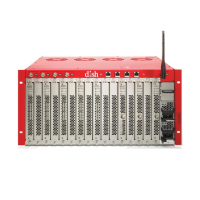38
NOTE: The NTSC blade supports 24 channels. These channels must be within a (144 MHz) contiguous frequency
block. For example, channels 7-13 are higher in frequency than 14-22. If you start at channel 10, there will be a
frequency hole and the blade will not support the full number of channels. Refer to Chapter 21 NTSC CHANNEL-
FREQUENCY for a table of channels and corresponding frequencies.
NTSC Output — 24 channels on 24 contiguous channel frequencies, EIA STD Channel Plan, 6 MHz per channel,
120-552 MHz range.
Max Services Per QAM Channel
The following maximum services per QAM channel should be adhered to for each type of service. Failure to do so
will result in sporadic performance issues.
Encrypted QAM – maximum of 4 services per QAM channel (e.g., 10-1, 10-2, 10-3, 10-4)
HD Over Coax – maximum of 2 services per QAM channel (e.g., 10-1, 10-2)
ATSC – maximum of 2 services per QAM channel (e.g., 10-1, 10-2)
Encrypted IP Stream Output
When configuring IP services for EVOLVE, the ports used can be the same or dierent for each service. For
standard bulk IP installations, follow the network and end device specifications.
• Enable – Checked
• Type – IP Stream
• Output – Desired IP/Port (e.g., 224.0.0.1:7000)
• Output Blade - Not an option
• Format – Native
• Encryption – Desired encryption (Pro:Idiom, Verimatrix, Lynk, or Simulcrypt )
• Priority – 1-99; default is 99 (1 is highest, 99 is lowest)
• Virtual Channel Number – Assign number (used for the Program Guide)
Click Apply in the Actions box located on the upper left of the page to lock-in the settings.
NOTE: IP Stream Output — Multicast, UDP/IP, SPTS, no Unicast, no IGMP support.
As SMARTBOX does not support IGMP joins, it outputs all of the multicast streams from the data port(s) configured
for Content IP. On site, the switches need to support IGMP to stop all of the trac from blasting out.
The basic sequence of events goes:
1. SMARTBOX is configured for X channels
2. X channels of multicast IP are output by SMARTBOX, using 500+mbs of the 1 GB connection
3. SMARTBOX is plugged into an IGMP switch
4. IGMP switch stops multicast trac flooding the network
When IGMP join is sent, the switch handles the join, and sends the single stream out the appropriate port to the
end point.
It is the responsibility of the network manager to configure the switches correctly and ensure the trac is handled
properly as the network settings and setup are specific to the individual network.

